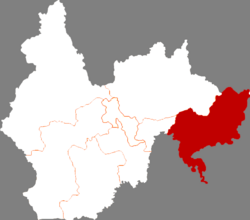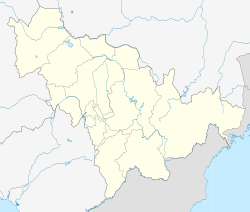Hunchun
珲春市 · 훈춘시 Hun-ch'un | |
|---|---|
 A street in Hunchun | |
 Hunchun in Yanbian | |
| Coordinates: 42°51′47″N 130°21′58″E / 42.863°N 130.366°E | |
| Country | People's Republic of China |
| Province | Jilin |
| Prefecture | Yanbian |
| Seat | Xin'an Subdistrict |
| Area | |
| 5,145.4 km2 (1,986.7 sq mi) | |
| • Urban | 125.39 km2 (48.41 sq mi) |
| Elevation | 41 m (135 ft) |
| Population (2017)[1] | |
| 271,000 | |
| • Density | 53/km2 (140/sq mi) |
| • Urban | 216,300 |
| Time zone | UTC+8 (China Standard) |
| Postal code | 133300 |
| Hunchun | |||||||
|---|---|---|---|---|---|---|---|
| Simplified Chinese | 珲春市 | ||||||
| Traditional Chinese | 琿春市 | ||||||
| |||||||
| Chinese Korean name | |||||||
| Chosŏn'gŭl | 혼춘시 | ||||||
| |||||||
| South Korean name | |||||||
| Hangul | 훈춘시 | ||||||
| |||||||
Hunchun (simplified Chinese: 珲春; traditional Chinese: 琿春; pinyin: Húnchūn; Chosŏn'gŭl: 혼춘) is a county-level city in the Yanbian Korean Autonomous Prefecture within Jilin province to the far east. It borders North Hamgyong Province in North Korea and Primorsky Krai in Russia, has over 250,000 inhabitants, and covers 5,145 square kilometers.[2][3] The site of the eastern capital of the Balhae Kingdom between 785 and 793, Donggyeong, was located here.
The city's name Hunchun comes from Huncun in Manchu language. (Manchu: ᡥᡠᠨᠴᡠᠨ, Möllendorff: huncun, Abkai: hunqun).[4] The city and the village Fangchuan is located near the point of junction of the borders of China, Russia, and North Korea; provided with an observation platform, it is a popular tourist attraction.[5]
- ^ a b Ministry of Housing and Urban-Rural Development, ed. (2019). China Urban Construction Statistical Yearbook 2017. Beijing: China Statistics Press. p. 50. Archived from the original on 18 June 2019. Retrieved 11 January 2020.
- ^ North Korean Economy Watch > News and analysis of the North Korean economy[permanent dead link]
- ^ "News and analysis of the North Korean economy : Koryolink continues to expand customer base". North Korean Economy Watch. November 17, 2009.
- ^ Emperor of Qing Dynasty (1771). 御製增訂清文鑑·卷十·人部一人類一·滿洲 [Enlarged and Revised Manchu Dictionary written by the Emperor of Qing (han -i araha nonggime toktobuha manju gisun -i buleku bithe, juwanci debtelin, niyalmai šošohon uju, niyalmai hacin uju, manju, 4-ci afaha)] (in Manchu). Vol. 10, Human-beings 1. p. 4.
- ^ Schmitz, Rob (November 16, 2015). "China's Frontier Towns > China bets big on border town with Russia, North Korea". Minnesota Public Radio.
